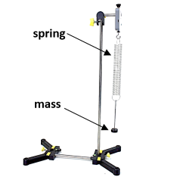PW2 : STATIC AND DYNAMIC STUDIES OF THE OSCILLATING PENDULUM
I. Goals :
- Highlight the movement of an elementary mechanical system: the oscillating pendulum.
- Determine the spring stiffness constant by two methods: static and dynamic.
- Measure the value of an unknown mass from the spring calibration curve.
II. USED MATERIAL :
- A support.
- A metal rod.
- A spring of negligible mass
- A box of marked masses.
- A graduated ruler.
- A stopwatch.
- A mass of unknown value.

III. THEORY :
III.1. Static study:
When a mass m is suspended from a spring, the latter lengthens and exerts a force F on the object responsible for its elongation; this force is called spring tension.
The elongation of the spring is noted xeq and is defined by:
![]()
where l0 : is the empty length of the spring
l : the length of the extended spring.
A stiffness spring k , whose mass will be neglected, is suspended vertically by its upper end from a support.
By applying Newton's first law, we have :
At Equilibrium :From where, by projection on the axis of movement oriented vertically, we obtain:

III.2. Dynamic study :
Using the previous spring, in addition to its first elongation Δl0 = xeq due to the clinging mass, we stretch the spring with a distance x (see Fig 2).
By applying Newton's second law, we have :By projection on the axis of movement oriented vertically, we get : px - Fx = ax
Using the relations :
![]()
![]()
Using the relation (1), we obtain the differential equation of the oscillatory movement.
![]()
We can thus determine the expression of the
period of the pendulum:

Physically, the period
represents
the time of one oscillation. 1.
Start by hanging the spring from the horizontal rod. 2.
Attach the ruler so you can take precise measurements. 3.
Measure the empty length l0 of the spring. 4.
Then you must first suspend the weight rack to be able to place the masses on
it. 5. Different
known masses (m
) of increasing values (see the table on the
TP-sheet) are attached to the spring. At equilibrium,
measure the corresponding elongations (X = xeq
), taking into account the mass of the weight
rack. For each mass, take a minimum of three
measurements (each student will take one measurement). Record your results in the table. 6. To
preserve the spring, you must unhook the mass directly after performing the
measurement. Never leave masses attached to the spring!! 7. On a
millimeter sheet, draw the calibration curve of the spring X = f(m).
We want to determine the unknown mass m of a
body from the calibration curve of the spring, for this : 1. Take the device used previously and put the unknown
mass to the spring. 2. Measure the elongation X of the spring. 3. Use the spring calibration curve to determine the
value of the mass m. 1. Resume the
previous device. Attach a known mass m to the spring. 2. Stretch
the spring (taking it away from its equilibrium position) a small distance,
perfectly vertically, then let go of the mass without initial
velocity. 3. Let the
mass oscillate and measure the period of the oscillations T (read and
carefully follow the measurement instructions on the sheet hung in the
laboratory). 4. For each
mass, take a minimum of three measurements (Each student will take one
measurement). 5. Change
mass and follow the same steps. Fill in the measurement table on the TP-sheet. 6. On a
millimeter sheet, draw the calibration curve of the spring T2 = f(m). IV. expErimental PROCEDURE:
IV.1.
Static study:
IV.2.
Determination
of the unknown mass of a body :
IV.3.Dynamic study :
